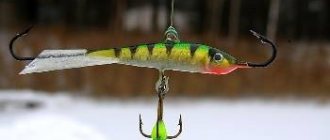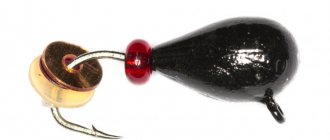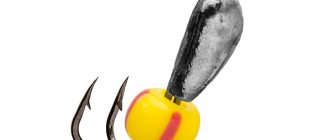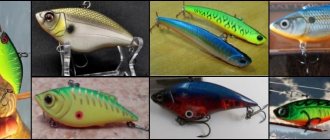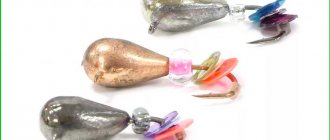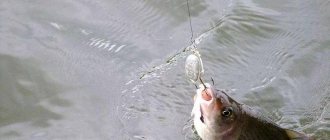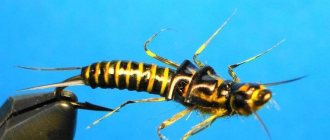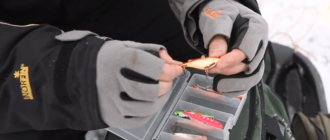Lenok is a freshwater predator from the salmon family. The young feed on plankton, insects and invertebrates. Upon reaching 3 years of age, it begins to eat frogs and small fish. Lenok overwinters in deep, warm pits. Large fish are located alone, small fish gather in small schools. When caught on a hook, the lenok actively resists and can break off close to the shore. This is a cautious and sensitive fish; if threatened, it immediately moves to another place. A popular fishing tackle in winter is lenka jigs.
Lenka habitats
Lenok lives in the foothills of rivers and mountain lakes. Found in the Far East and Siberia in reservoirs with clean water. In winter, the lenok actively moves in search of food at a depth of 5-100 cm. But if it settles in a deep hole, its activity will decrease and it is impossible to catch the lenok.
It is good to catch large lenok in winter on river channels, in bays with standing water, next to riffles, in shallow lakes, next to snags.
How to catch?
Fishing with a jig is a popular way to get a big catch of lenka during the cold season. This type of fishing is effective, but labor-intensive, because it depends on many factors. These include:
- depth of the reservoir;
- current in a body of water;
- choice of nozzle;
- correct handling of the jig.
Fishermen pay special attention to the last factor. You need to play continuously with the jig. Oscillation frequency is 100−200 movements per minute. The nozzle is placed at a height of 2-3 cm from the bottom.
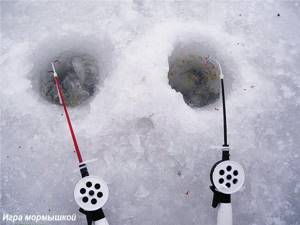
It can be from natural products: a bunch of worms, red meat, insects, larvae, small frogs or ordinary mice. Artificial mice and flies for catching lenka are on sale.
Fishing for link in winter
Winter fishing for lenok is different in that it is better to catch it in channels, and not in the river itself. This is due to the fact that when there is freezing on the river, all the places where fish can live are clogged with ice, and the channels, having an average current, remain clean. Since the lenok loves clean water, for the winter it moves to oxbow lakes, closer to the rifts, to holes in shallow water.
Tactics and technique
During the winter months, the lenok behaves quite actively. However, you need to constantly look for it. This is a cautious type of fish. He easily senses danger and quickly goes to another place. If the fish stops biting, then it is better to move 100-200 steps away and throw the tackle in another place. After a while, you can return to your old place and try your luck again. During the absence of the fisherman, the school calms down, and the fish can bite on the offered bait.
The fishing technique is to force the fish to pay attention to the jig. To do this, you need to constantly play with bait. It is smoothly raised and lowered to a small height above the bottom of the reservoir. It is important to take short breaks at the top and bottom points of the lift. While the bait is hanging, the lenok grabs it.
Fishing rod equipment
For success in fishing, it is important to assemble the tackle correctly. This applies equally to fishing with spoons and jigs. To catch large lenok with a jig, a sensitive fishing rod is assembled. A plastic rod 20-30 cm long is selected. A reel and whip are attached to it. The size of the whip is 15 cm. In order for the jig to play correctly, the fishing line is taken with a thickness of 0.18-0.22 mm. Thicker thread will worsen the performance of the bait. Before going fishing, jigs are sorted by weight, and depending on the weight, the length and width of the nod are selected.
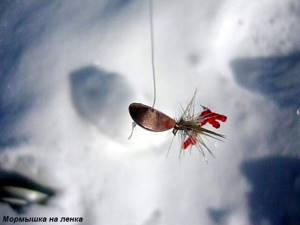
For the lure, choose a rod up to 0.5 m long with a simple inertial reel and whip. You can use a reel instead. The spoon is attached to a monofilament line 10-30 m long. Its thickness is 0.3-0.4 mm. As with the jig, choose a nod for the chosen spinner. The bite alarm must be rigid.
Tackle
Braided line is used as fishing line in winter. The fish are not interested in the color of this line, so in order for the angler to be able to follow the wiring, it is better to choose fluorescent leaders. Such tackle will not scare away the cautious lenok. Thin braids are more resistant to the influence of current and wind and show good sensitivity. Making a fishing rod is simple, but the thin cord often gets caught and there is a danger of it breaking and losing the bait.
The braid is selected depending on the intended fishing method and the tensile strength value. Manufacturers indicate it in kg or lb. To convert lb units to kg, the lb value is multiplied by a factor of 0.44.
Inertia and non-inertia coils. Fishermen use both types. Some are attracted by the simplicity and low price of inertial. Others like spinning jigs for their casting range and resistance to beard formation.
Fishing method
To attract the attention of the fish, you need to lower the jig to the bottom, fix the line at the end of the fishing rod, and with a small twitch of the brush (“play”), lift the bait 5-10 cm up for 2-3 seconds, then let it fall to the bottom again. Such movements are repeated until the bite occurs with a short interval.
If you feel a small bite, and in winter the fish is half asleep, although it is difficult to say about lenka, you should not expect sharp jerks, as in the summer, you need to quickly hook it and bring it onto the ice.
You shouldn’t stay too long on one hole, lenok is an attentive and cautious fish and, sensing something is wrong, can leave at any moment if there is a way out of the hole or give up the bite. Therefore, after 1-2 successful conclusions, it is best to let the fish calm down, and you can continue fishing by drilling another hole a few tens of meters away and try your luck there.
Read! Catching sabrefish in winter
The best jigs for winter fishing for lenka
For winter catching lenok, elongated teardrop-shaped jigs are used. The metal base of the bait is located at the top. Material - copper, brass, sometimes stainless steel, cupronickel or silver is used. For large bait, such as frogs, a bunch of worms, and small fish, use jigs with a shifted center of gravity to the front. This bait deviates strongly from the line, which is convenient for using bulk baits. For small bait - artificial flies, caddis flies, bark beetles, wormwood larvae - choose evenly balanced jigs.
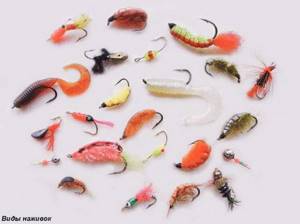
In jigs for small bait, the hook is soldered without an angle towards the bait. For large baits, place the hook at an angle to the jig.
Lenok on the balance beam: winter fishing
Experienced fishermen are fond of this method of catching lenka during the freeze-up period. Tackle is assembled from an ice fishing rod with a reel and fishing line. Balancers are fish-shaped bait used to catch predators. The size of the bait is 3−4 cm, weight 4−6 g. The color of the balancer is usually bright, reminiscent of the natural coloring of fry. For a good catch, the hooks of the balancer must be sharp.
The balancer is selected according to the nature and size of the reservoir. At depths of up to 3 m and in small bodies of water, small bait models are used. On large and deep-sea lakes, massive balancers are used.
What to catch lenka with
Catching this representative of salmon in winter requires using specific baits. They can be divided into several categories.
- cross-type artificial baits when fishing . In such spinners, the center of gravity is located in the middle, like a balancer. After lowering into the water, the bait takes a horizontal position. “Beetles,” “whitefish,” and “crabs” have become popular models among Far Eastern fishermen.
- Lenka jigs also have certain distinctive features These are large models with an elongated lead body. Fish respond better to jigs that have a metal plate on top and a soldered layer of lead on the bottom. Experienced fishermen make their own baits using copper or brass as a base. But silvery metals (stainless steel, cupronickel, silver) are used very rarely. Sufficiently large hooks from No. 6 to No. 12 are also soldered in.
Photo 2. Jig in the shape of a beetle.
- Among the baits, the most popular bait in winter is the caddis fly . It is mined in non-freezing streams and rivulets. Geese and stoneflies can also be found under the stones. On the shore, white grubs live in the thistle stems. And under the bark of fallen trees it is not difficult to find a bark beetle. You should also take worms, salted salmon caviar and freshwater shrimp with you. And it is best to offer a large lenok a frog.
- Particularly skillful fishermen manage to seduce lenok with artificial baits. First of all, these include various fly fishing flies . The fisherman's arsenal should include imitations of bloodworms and maggots.
Photo 3. Lenka flies.
Making winter jigs for Lenka
To get the most catchy jigs, many anglers combine them with artificial flies. This kind of hand-made bait, in the form of weighted flies of various designs, has been used by fishermen since the last century. Homemade jigs are made by soldering.
They have several advantages over ordinary teardrop-shaped baits:
- imitate the head of an insect;
- have a variety of shapes;
- fewer hooks, due to the fact that the fly agarics are located at right angles to the fishing line.
This bait has larger and “humpbacked” hooks. You can watch how to properly make a homemade jig on the YouTube channel. Many experienced fishermen posted videos of master classes on making homemade baits there.
Making jigs at home
Winter jigs are made using simple bolts. The head of the selected product should be large. The size of the future bait depends on this. The bolt head is turned by hand or on a machine. After rough grinding, the workpiece is polished with GOI paste. A birch log is selected from a piece of wood, and indentations are made with the heated blank.

From a sheet of copper purchased from the radio components department, squares are cut to fit the size of the recesses in the block of wood. The copper squares are given the desired shape using a bolt blank, the excess copper is cut off and the curved plates are inserted into the recesses in the wood. A hook is placed into the resulting container and a small needle is driven into the middle. The form is filled with solder.
A hole is drilled in the resulting jigs, then it is flared. The device is well sanded.
Manufacturing methods
Homemade fishing devices are made in the following ways:
- casting;
- soldering;
- instrumental method.
Cast baits are made from lead. You can solder a jig from tin and its alloys. The instrumental method is used for tungsten crafts.
The procedure for making a jig “eye”
To make an “eye” bait, you need to purchase a PCB or getinax plate. Plate thickness 10 mm. In the textolite, holes are made with a drill, which give the shape of an eye to the jig. The size of the recess depends on the diameter of the drill. The weight and shape of the bait depends on the drilling depth. An elongated scale-shaped shape will be obtained with deep drilling; with shallow drilling, the shape of a drop will be obtained.
The hole for the fishing line is drilled with a nail of the required diameter with a bitten off head using an electric drill. A steel rod is inserted into this hole. File the surface of the hook with a file.
Soldering acid is applied to the hole, as well as to the base and top of the hook. Tin is applied to the hook. It is secured above the recess using a piece of wine cork. The resulting mold, together with the hook, is filled with molten tin to the desired shape.
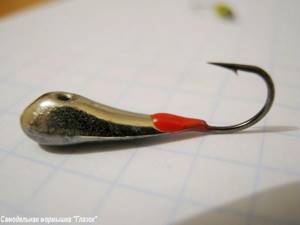
After the tin has cooled, the steel rod is removed. The jig is processed with a needle file. Using a drill, smooth out the sharp edges of the hole for the fishing line.
Lead baits without casting
For bait without casting, take a suitable hook, heat the eye with a flame and bend it inward. Clean it with a file. A piece of lead is separated along the length of the hook. It is thoroughly cleaned and a recess is made for the hook. Tinning is performed with melting acid. Then, using tin, the hook is soldered to the lead blank. The soldering area is cleaned with a file and sandpaper. Painted in the desired color.
What is the best jig for catching lenok?
Some fishermen consider “knitted baits” to be the best tackle for lenka. The peculiarities of the jig consist in winding a “fly” from threads of a brick or dirty pink shade a third of the length of the hook with a drop-shaped soldering. The bait is placed on the part free from the thread.
Such bait equipment requires additional loading of the gear. To do this, an additional weight is installed on the fishing line above the jig at a distance of 10-15 cm, which helps to play the bait correctly and easily detect the bottom.
Tactics and fishing techniques
The bite is often a way out. After capturing several individuals, the flock may scatter. Regardless of fishing methods, it is worth being active in fishing and not staying in one place for too long. Fishing with an artificial mouse is carried out during the period of “liquid” water. In addition to the effectiveness, the fishing turns out to be spectacular, because bites occur near the surface. Imitations of rodents, both branded and homemade, are used as bait.
Catching lenok with a “mouse” is as effective as with a spinner. To do this, the bait is thrown a little upstream from the promising point, under the opposite bank. The wiring should be uniform, exactly simulating a rodent swimming across a river. If the fish does not show interest, it makes sense to change the bait to another model, smaller or in a different color.
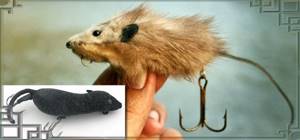
How to make a mouse
The greatest number of bites occurs in the evening. This is due to the activity of rodents at night. You can try this method at nightfall and at dawn. The mouse is made with your own hands from a dense black material. A metal wire is threaded through the body, having ears on both sides. A tee is mounted on the back, and the front ring serves as a hook for the carbine. The compound mouse is in demand among predators. The mobility of the body attracts the lenok and provokes it to attack.
To learn more:
Muksun fish - structure, habitats, spawning
Bottom tackle
In Transbaikalia and other regions of Siberia, the running donka is popular. Structurally, it consists of several elements:
- main line, 0.3 mm in diameter;
- a sinker that will hold the equipment at the bottom;
- one or two leashes.
Fry, insects and worms are used as bait. The tackle is waded on the stream or carefully cast from the shore. The “Zakidushka” can be used both in fast and moderate currents, by adjusting only the weight of the sinker used.
The advantage of the rig is the detection of feeding fish at relatively large depths. There are times when a school cannot be detected on the surface of the water, and it is in such situations that the donka comes to the rescue.
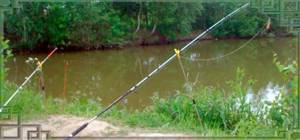
Downhill fishing method
Not so common among lenok hunters. Its huge disadvantage is the constant loss of bait, because fishing is carried out along the bottom of the river, where the tackle catches snags and large stones. The design's appearance resembles a donkey and differs only in the use of a smaller sinker and one leash. The gear is thrown upstream. A light sinker is carried away by an abundant flow, rolling along the bottom, which gives it its characteristic name. You should watch the line tension carefully and at the slightest stop, immediately hook. The bait used is the same as for donkey, but the bites are more careful.
Spinning tackle
When talking about this method, we mean a large number of baits and subcategories of this fishing method. Gear for catching lenok is used in the medium class with an upper test limit of up to 30-35 g. The reel is used of the inertial type.
Budget models do a poor job of laying out the cord, which will result in “beards.” There is no need to skimp on this part. Braided cord has long replaced its monofilament counterpart. The fishing line is used only by old-school local fishermen.
The box must contain all popular types of bait. Wobblers for lenka are also used for grayling, since these species have similar tastes. Despite the transparency of mountain rivers, the fish in them prefer bright colors. Red and green are excellent at tempting predators to bite. Lenka spinners can be painted or have a sticker on the body, are made by hand and, just like wobblers, can be used for grayling.
To learn more:
Catching Black Sea shrimp - the best ways

It is better to fish with a spinning rod while standing in the water, since the banks of taiga rivers are covered with dense vegetation, which interferes with free movement. A good bite begins at the end of August, and the peak of activity occurs in September - October. The choice of bait depends on the season, weather and fishing conditions. In a steady flow, a jig is used instead of the usual wobbler or spoon. Spinning gear for lenka is vaguely reminiscent of trout fishing - similar baits, retrieves and fishing tactics.
